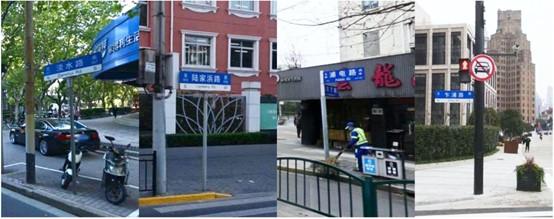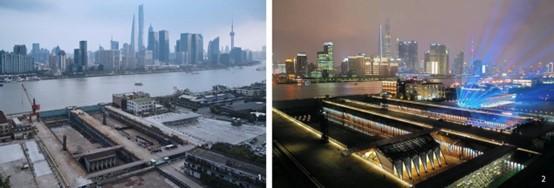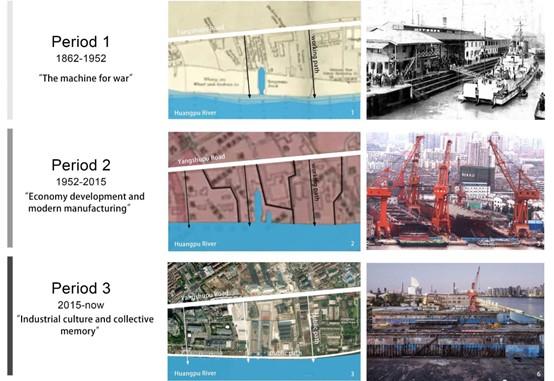Gong Zhang
In the free online course Water Works: Activating Heritage for Sustainable Development learners make a portfolio addressing the spaces, transitions, challenges, stakeholders and values of a port city territory of their choosing. We motivate the learners to reflect on their learning and invite them to present their findings in a blog. In this blog, learner and PhD researcher Gong Zhang writes about the Shanghai Shipyard Puxi Branch, one of the birthplaces of China’s shipbuilding industry, listed as Chinese National Industrial Heritage, and once the largest shipyard in the Far East.
Shanghai, the largest port in the world, is a city nurtured by well-developed river and sea transport. Nowadays, there are still many places named after water bodies in Shanghai, like 浦(waterfront), 湾(bay), 港(harbor), 湖(lake), 淀(shallow lake), 汇(confluence), 江(big river), 河(river), 泾(small river), etc. Some rivers in Shanghai are still in use for transport today, while others have been filled in as roads. Nevertheless, the local place names containing ‘river’ (Fig.1) continue to represent the importance of water in Shanghai’s history and culture, and its once-thriving fishing and shipping industries.

Ripples in a Pond: Shanghai Shipyard Puxi Branch
The Shanghai Shipyard Puxi Branch, which lies in the northeast of Shanghai, serves as a lens to show how the city’s development has been closely connected to the water. This shipyard is near the important Yangshupu River, which flows into the Huangpu River. The area through which the river flows is called the Yangpu District nowadays. Many other places are named after this river, like Yangshupu Road, Yangshupu Power Station, Yangshupu Post and Yangpu Bridge. Yangshupu River has nurtured this area and the people living here.
The area where Shanghai Shipyard Puxi Branch is located is called the Yangpu Riverfront, which was a famous industrial shoreline rather far from the city center in history, bordered by the vast river and with convenient water transportation. The shipyard used to act as a transition point between sea and land transportation. Raw materials were quickly transported to the shipyard through waterways and roads, where they were then manufactured and processed to build ships. The ships could then be transported directly from the shipyard into the Huangpu River, and subsequently through the Yangtze River into the East Sea (Fig.2). The Yangpu Riverfront, which stretches 5.5km from east to west, was not only home to a large number of factories, but also to a large settlement for factory workers on the north side of Yangshupu Road (Zheng, 2020).

Today, with the rapid expansion of Shanghai city, the shipyard that once lay on the periphery of town now finds itself near the city center and is regarded as an important public space, a picturesque waterfront and a historic heritage site, with significant social, cultural and economic values. The shipyard also serves as a symbol of industrial civilization, carrying the collective memory of its former workers. For the Shanghai Urban Space Art Season (SUSAS) 2019 art exhibition, the shipyard was renovated and used as one of the main exhibition venues, and its two docks were transformed for various cultural and artistic displays (Fig.3) (Mo & Qin, 2020).

Spatial Evolution: From Closed Factory to Open Space
The rich history of Shanghai Shipyard Puxi Branch dates back to 1862 (Urban Planning Society of China & National Academy of Innovation Strategy, 2019), encompassing periods of war, commercial shipyard operations, industrial heritage status, and the vibrant open urban public space it functions as today.
Period 1: The Machine for War (1862-1952)
Shanghai Shipyard Puxi Branch witnessed the development and integration of foreign-funded and national shipyards. The shipyard was first built by a German company and was named Ruirong Shipyard, specializing in the construction of shallow water vessels, tugs, barges and excursion boats(Mo & Qin, 2020). After the First World War, it was transferred to the British Union Shipyard Company, and the scale of the shipyard expanded to an area of 300,000 square meters and nearly 1,000 employees, mainly building British, American, Japanese and Italian war vessels (Wang, 1986). After the Pacific War, the shipyard came under the Japanese ownership of the Mitsubishi Corporation, specializing in the repair of Japanese war vessels (Xin, 1999). The shipyard became “one of the largest shipbuilding monopolies in the East” (Urban Planning Society of China & National Academy of Innovation Strategy, 2019). During this time, Shanghai Shipyard Puxi Branch was located at a good riverfront location, with an irregular shoreline of mudflats (Fig.4-1). Factory houses were built around the main dock of the shipyard.
Period 2: Economic Development and Modern Manufacturing (1952-2015)
After the founding of the People’s Republic of China, the shipyard was returned to state ownership and operated by the Shanghai Shipyard Company (Mo & Qin, 2020). During this era, the shipyard was mainly used for economic and scientific purposes. The shipyard built China’s first 2000hp low-speed diesel engine (1958), China’s first exported 10,000-ton vessel ‘Shaoxing’ (1978), the first semi-submersible offshore oil rig ‘Exploration No. 3’ (1984), etc. (Urban Planning Society of China & National Academy of Innovation Strategy, 2019). The scale of the shipyard expanded from its original dock into two parallel docks, with factories, dormitories and other buildings around it. A new, neat shoreline along the river was constructed (Fig.4-2). The Yangshupu Road, built by the Public Settlement Authority in 1869, became an increasingly important logistical route for the many factories along the river (Zhang, Zhang, Zhang, et al., 2019). The spatial layout during this period remained stable, and the dock did not undergo major changes.
Period 3: Industrial Culture and Collective Memory (2015-present)
Shanghai Shipyard Puxi Branch completed its historical mission and closed in 2015 when the Shanghai Shipyard Company moved to Chongming Island (Mo & Qin, 2020). In the same year, the Municipality of Yangpu District proposed to build a globally influential technology and innovation district in Shanghai, while preserving the historical landscape and industrial heritage of the Shanghai Shipyard area (Zheng, 2020). In 2019, the Shanghai shipyard was selected for the Second List of Industrial Heritage, for the representation of the development of Shanghai and China’s shipbuilding industry since modern times (Urban Planning Society of China & National Academy of Innovation Strategy, 2019).

Nowadays, the spatial layout of the shipyard heritage site is a complex that contains two big docks, cranes, warehouses and factories (Fig.4-3). People can enter the docks to observe the internal structure. The riverside trail links the factories that are close to each other and gives the public more opportunities to directly walk to the river (Zhang et al., 2019). The shipyard, together with other densely concentrated heritage sites along the Yangpu waterfront, now forms a new urban landscape where art, industrial heritage, infrastructure and public space seamlessly intertwine with one another.
Stakeholder Challenges
The shipyard’s current conservation and management processes involve multiple stakeholders. The Shanghai Municipal Government is the most powerful stakeholder, undertaking the governance, supervision and guidance roles. Local inhabitants are the main daily users of the heritage site, indirectly participating in the decision-making and heritage management process (Li & Zhong, 2021). Entrepreneurs and investment companies, on the other hand, undertake heritage reuse and commercialization operations. Experts, such as researchers, architects, urban planners, etc., play a professional advisory role to the government and the public, contributing to making more scientific decisions.
The shipyard still faces various kinds of challenges, however, the decaying waterfront industrial heritage faces the biggest challenge to retain economic priority from state and private investments, threatened by a lack of focus on its social and cultural values, and the benefits for citizens’ everyday life (Den Hartog, 2019). Despite being interconnected through a government-led system, multiple stakeholders still experience conflicts with each other. These conflicts arise from various factors, such as the government’s economic dependence on land finance versus heritage conservation (Den Hartog, 2021), and the divergence between the public interests of citizens and the private interests of companies. Regrettably, extensive and efficient public participation remains lacking in this context, and the powerful government and its subsidiaries in universities and architecture companies continue to dominate the decision-making (Li & Zhong, 2021).
Following the UNESCO Historic Urban Landscape approach (UNESCO, 2011), the government needs to further integrate heritage conservation into wider urban sustainable development, involving public engagement as well. To enhance public awareness of the Shanghai Shipyard Puxi Branch’s history, values and vulnerabilities, the local community could invite experts to hold public seminars. Community planners together with the local government could establish a platform that allows the public to share their suggestions and participate in water heritage conservation and renewal. Furthermore, the conservation of heritage sites needs to go beyond focusing on isolated heritage buildings, and involve a wider urban context. To promote the adaptive reuse of heritage sites, the government should further consider providing suitable financial incentives and subsidies.
Acknowledgment
The free online course Water Works: Activating Heritage for Sustainable Development runs on the edX platform. This blog has been written in the context of discussions in the LDE PortCityFutures research community. It reflects the evolving thoughts of the author and expresses the discussions between researchers on the socio-economic, spatial and cultural questions surrounding port city relationships. This blog was reviewed and edited by Vincent Baptist and Ekaterina Plekhanova.
Reference
Den Hartog, H. (2019). “Re-defining the Appreciation and Usability of Urban Watersides in the Urban Center and Peri-Urban Fringes of Shanghai.” European Journal of Creative Practices in Cities and Landscapes 2(1), 37-64. https://doi.org/10.6092/ISSN.2612-0496/8918.
Den Hartog, H. (2021). “Shanghai’s Regenerated Industrial Waterfronts: Urban Lab for Sustainability Transitions?” Urban Planning 6(3), 181-96. https://doi.org/10.17645/up.v6i3.4194.
Li, Y., & Zhong, X. (2021). “‘For the People’ Without ‘by the People’: People and Plans in Shanghai’s Waterfront Development.” International Journal of Urban and Regional Research 45(5), 835-47. https://doi.org/10.1111/1468-2427.12964.
Mo, L., & Qin, S. (2020). “Continuing the History of Chengxin's Steel and Wood Speed Building: Temporary Renovation of No. 1 and No. 2 Dock at the Old Shanghai Shipyard Site.” Architectural Techniques 26(11), 92-9.
UNESCO (2011). “Recommendation on the Historic Urban Landscape.” UNESCO World Heritage Centre. https://whc.unesco.org/en/hul/.
Urban Planning Society of China & National Academy of Innovation Strategy (2019). The Second List of Industrial Heritage.
Wang, Z. (1986). The History of Modern Chinese Shipbuilding. China Ocean Press.
Xin, Y. (1999). A Brief Discussion of the Historical Achievements of China’s Modern Shipbuilding Industry. Shanghai Ancient Books Publishing House.
Zhang, M., Zhang, Z., Qin, S., & Wang, X. (2019). “Demonstration Section of Yangpu Riverside Public Space, Shanghai, China.” World Architecture, 130-3.
Zhang, M., Zhang, Z., Zhang, J., Qin, S., & Wang, X. (2019). “The Revival of Waterfront Public Space in the South Section of Yangpu Riverfront, Shanghai.” Journal of Architecture 8, 16-26.
Zheng, S. (2020). “The Past Life and Present Life of the Yangpu Riverfront.” Architectural Practice, 28-31.
